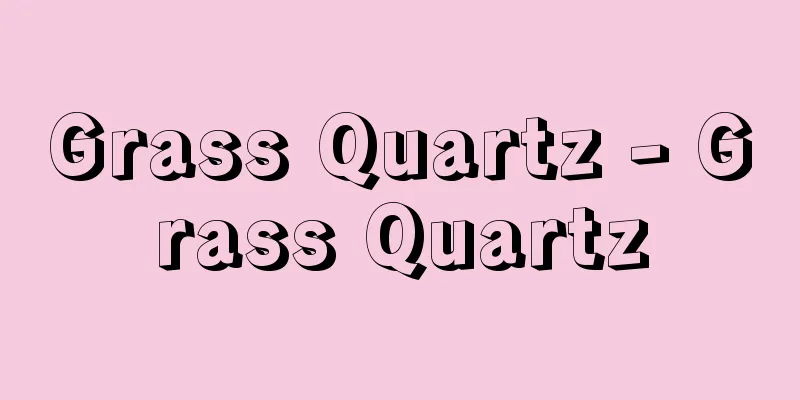Ikko Ikki - Ikko Ikki

|
Armed uprisings by followers of the Ikko sect (the Shinshu Honganji sect before it split into eastern and western sects) that took place from the mid-Muromachi period through the Warring States period, using the organization of the sect. The first was the Omi Kanamori Rebellion in 1465 (Kansho 6) and the last was the fall of Ishiyama Honganji in 1580 (Tensho 8), but they can be divided into three stages based on the nature of the uprisings. The first stage was the period up until the end of the 15th century when the sect was being formed, mainly in the Hokuriku region, and began with the apologetic Kanamori Rebellion, which rose in resistance to the oppression of the Ikko sect by Enryakuji Temple. These include the Kaga Ikki (Bunmei Ikki) in 1474 (Bunmei 6), which was ordered by Renyo of the Hongan-ji Temple in Yoshizaki, Echizen (Awara city, Fukui prefecture) to intervene in the succession dispute of the Togashi family, the guardian of Kaga, and support Masachika and defeat his younger brother Kochiyo; the Ecchu Tonami-gun Ikki in 1481, which overthrew the local lord Ishiguro clan; and the Kaga Province Ikki (Chokyo Ikki) in 1487 (Chokyo 1), which rose up in opposition to the heavy impositions of guardian Masachika and the oppression of the Ikko sect, and destroyed Masachika in June of the following year. In particular, in Kaga, where they had overthrown the Shugo, they supported the Togashi clan as nominal Shugo, and from the 1530s they looked up to the head priest of Hongan-ji Temple as their lord, and maintained control of the province through a double "ikki" (a coalition of local lords) consisting of three Ikkeshu temples, a "gun" (county) and its subordinate "kumi" (group), until 1580 (Tensho 8). It is said that in 1485 (Bunmei 17), the Hida Ikki fought against the Uchigashima clan. The second stage was in the first half of the 16th century, when Hongan-ji Temple established its position as a political force. In 1506 (Eisho 3), under the orders of Hongan-ji Jitsunyo, who had become a supporter of Kanrei Hosokawa Masamoto, a large uprising broke out in Kinai and Hokuriku against Masamoto's opponents, the Asakura clan of Echizen, the Hatakeyama clan of Echigo, and the Uesugi clan of Echigo. The Echigo Uprising killed Echigo Shugodai Nagao Yoshikage in battle, and brought western Echigo under the control of the "uprising" along with Kaga (Eisho Uprising). In 1531 (Kyoroku 4), a power struggle broke out in Kaga, with a large uprising by the Hongan-ji Temple side fighting against a small uprising by the three Ikkai temples of Honsen-ji, Shoko-ji, and Kokyo-ji, with the large uprising winning (large and small uprisings). In 1532 (Tenbun 1), followers of the Kinai region rose up in revolt under the orders of Hongan-ji Shonyo, and attacked Miyoshi Motonaga in Sakai, forcing him to commit suicide. This was a strategy by the patron Hosokawa Harumoto to overthrow the opposition. However, when Harumoto, fearing the power of the rebellion, turned against Hongan-ji, the rebellions of followers in the Kinai region rapidly expanded, and they fought against Harumoto's forces and the Hokke Ikki in Yamato, Kawachi, Settsu, Izumi, Omi, and other areas. At first, the rebels were dominant, driving Harumoto out of Sakai, but the Hokke Ikki burned Yamashina Hongan-ji, and Harumoto resurrected and launched counterattacks, so they gradually found themselves on the defensive. Hongan-ji, which had moved to Ishiyama, Settsu (Osaka City), was also frequently attacked by Harumoto's forces, and a peace treaty was concluded in 1535. These two major rebellions established Hongan-ji's position as a major political force in the Kinai region. The third stage was the confrontation with Oda Nobunaga in the 16th century and the end of the Ikki. Tokugawa Ieyasu, who had already become an ally of Nobunaga in 1562 (Eiroku 5), fought the Mikawa Ikki in 1563. The Ikki rose up in protest against Ieyasu's violation of the right of local high priests not to enter temple grounds, and the vassals split into two and continued to fight fiercely until February of the following year, but they surrendered to Ieyasu, who succeeded in driving a wedge between the samurai and peasant followers of the temple. In 1568, Nobunaga went to Kyoto accompanied by Ashikaga Yoshiaki, and in 1570 (Genki 1), Honganji Kennyo ordered all followers across the country to rise up in a general uprising. This was the start of the so-called Ishiyama War. The Hongan-ji Temple allied with anti-Nobunaga daimyo such as Takeda, Asakura, Azai, Rokkaku, Mori, Uesugi, and Araki, and formed an encirclement of Nobunaga through uprisings in the Kinai, Tokai, and Hokuriku regions. Nobunaga repeatedly made nominal peace agreements with the Hongan-ji Temple, while continuing to defeat the uprisings one by one in various regions. The Omi Uprising cooperated with the Rokkaku and Azai clans and fought against Nobunaga's forces in various regions, but collapsed with the downfall of both clans. The Owari, Mino, and Ise Uprisings, centered around Nagashima Gansho-ji Temple, were so powerful that they attacked Nobunaga's younger brother Nobuoki, forcing him to commit suicide, but were destroyed in 1574 (Tensho 2) after three attacks by Nobunaga. In Echizen, rebellions broke out taking advantage of the power struggles among Nobunaga's retainers, and with the help of the Kaga Rebellion, they defeated Nobunaga's retainers in January 1572 (Genki 3) and achieved control of the entire province. However, they were annihilated in an all-out attack in August 1575 (Tensho 3), and the southern half of Kaga was occupied by Nobunaga's forces. The rebellions of the five Saika districts in Kii were part of the Kishu Sokoku Rebellion, and once surrendered to Nobunaga in 1577, but the two anti-Nobunaga districts rose up again and supported Hongan-ji with a large number of guns and naval forces. Meanwhile, Hongan-ji, which had been forced into a siege since 1576, often defeated Nobunaga's forces with the help of its Kinai followers and the Mori clan, but its military strength was weakened by the defeat of the rebellions in various regions and the retreat of the Mori clan, and it finally made peace in March 1580. Kennyo retreated to Saginomori in Kishu (Wakayama City), and Kyonyo, who opposed the peace treaty, also retreated in August; with the end of the Ishiyama War, the Ikko Ikki uprising came to an end. The Ikko Ikki can be classified according to their causes. They were those to defend their faith, those with a strong national character in which followers who had become the majority in a region joined forces with non-believers to gain control of a region or a country, those mobilized as a military force for the "lord of the temple" Hongan-ji, and those in opposition to Nobunaga, who aimed to unify the country. In all cases, at the root of them was the strong demand for the defense of faith as well as the strong demands of small lords and farmers who sought to reduce their burden by making the most of the multi-layered land ownership system. This, combined with the demands for regional control by the local lords who looked up to the Hongan-ji head priest as their lord, became a powerful military force, pushing Hongan-ji into a major political force in the Sengoku period and forming a system of feudal rule that was different from that of the Sengoku daimyo. Therefore, a confrontation with Nobunaga, who was the overlord of the Sengoku daimyo who sought to build a unified system of surplus exploitation, was inevitable. [Kiichi Shingyo] "Study of the Ikko Ikki by Kasahara Kazuo (1962, Yamakawa Publishing)" ▽ "Ikko Ikki - Their Actions and Thoughts by Kasahara Kazuo (1970, Hyoronsha)" ▽ "Study of the Ikko Ikki by Inoue Eio (1968, Yoshikawa Kobunkan)" ▽ "Study of Medieval Shinshu Thought by Shigematsu Akihisa (1973, Yoshikawa Kobunkan)" ▽ "The Basic Structure of the Ikko Ikki by Shingyo Kiichi (1975, Yoshikawa Kobunkan)" ▽ "Study of the Ikko Ikki by Kitanishi Hiroshi (1981, Shunjusha)" [References] | | | | | | | | |Jodo | | | | |Hongan- |Yamashina | [Chronology] |©Shogakukan "> The origins and occupation areas of the Ikko Ikki Source: Shogakukan Encyclopedia Nipponica About Encyclopedia Nipponica Information | Legend |
|
室町中期から戦国時代にかけて起きた一向宗(東西分派以前の真宗本願寺派(しんしゅうほんがんじは))信者の、教団組織を利用した武装蜂起(ほうき)。1465年(寛正6)の近江(おうみ)金森一揆(かながもりいっき)が最初で、1580年(天正8)の石山本願寺の陥落を最後とするが、一揆の性格により3段階に分けて把握できる。第1段階は15世紀末までの北陸を中心とした教団組織の形成期で、延暦寺(えんりゃくじ)による一向宗弾圧に抵抗して蜂起した護教的な金森一揆に始まる。1474年(文明6)越前(えちぜん)吉崎(よしざき)(福井県あわら市)にあった本願寺蓮如(れんにょ)の指令で、加賀守護富樫(とがし)家の家督争いに介入し、政親(まさちか)を支援して弟幸千代(こうちよ)を倒した加賀一揆(文明一揆(ぶんめいいっき))、1481年国人(こくじん)領主石黒氏を倒した越中礪波郡一揆(えっちゅうとなみぐんいっき)、1487年(長享1)に守護政親の重課と一向宗弾圧に反対して蜂起し、翌年6月に政親を滅ぼした加賀の国一揆(くにいっき)的一向一揆(長享一揆(ちょうきょういっき))である。とくに守護を打倒した加賀では、名目上の守護に富樫一族を擁立し、1530年代からは本願寺法主(ほっす)を主君と仰ぎ、一家衆(いっけしゅう)三か寺、「郡」とその下部の「組」という二重の「一揆」(在地領主連合)による一国支配を、1580年(天正8)まで維持した。なお1485年(文明17)に飛騨一揆(ひだいっき)が内ヶ島氏と戦ったと伝えられる。 第2段階は16世紀前半、本願寺が一つの政治勢力としての地位を確定した時期である。1506年(永正3)管領(かんれい)細川政元(ほそかわまさもと)派となった本願寺実如(じつにょ)の命令により、政元の反対派の越前朝倉(あさくら)、越中畠山(はたけやま)、越後(えちご)上杉(うえすぎ)氏らに対する畿内(きない)、北陸の大一揆が蜂起した。越中一揆は越後守護代長尾能景(ながおよしかげ)を戦死させ、越中西部を加賀と同じく「一揆」支配下に置いた(永正一揆(えいしょういっき))。1531年(享禄4)加賀に権力争いが起こり、本願寺方の大一揆と一家衆本泉寺(ほんせんじ)、松岡寺(しょうこうじ)、光教寺の三か寺方の小一揆が戦い、大一揆が勝利した(大小一揆)。1532年(天文1)畿内の門徒は本願寺証如(しょうにょ)の指令で蜂起し、堺(さかい)に三好元長(みよしもとなが)を攻めて自殺させた。これは外護者(げごしゃ)細川晴元(はるもと)の反対派打倒作戦であった。しかし一揆の力を恐れた晴元が反本願寺に転ずると、畿内門徒の一揆は急速に拡大し、大和(やまと)、河内(かわち)、摂津、和泉(いずみ)、近江などで晴元勢や法華一揆(ほっけいっき)と戦った。初めは晴元を堺から追い出すなど一揆方が優勢であったが、法華一揆に山科本願寺(やましなほんがんじ)を焼かれ、再起した晴元の反撃でしだいに守勢となった。摂津石山(いしやま)(大阪市)に移った本願寺もしばしば晴元勢の攻撃を受けるに至り、1535年に講和が結ばれた。二度の大一揆によって畿内の一大政治勢力としての本願寺の地位は確定した。 第3段階は、16世紀の織田信長との対決、一揆の終結期である。すでに1562年(永禄5)に信長の同盟者となった徳川家康は、1563年に三河一揆と戦っている。一揆は、家康による地方大坊主の寺内不入権侵害に抵抗して蜂起し、家臣団も二分して翌年2月まで激しい戦闘を続けたが、門徒の武士と農民の離間に成功した家康に屈服した。1568年に足利義昭(あしかがよしあき)を奉じて上洛(じょうらく)した信長を「法敵」として、本願寺顕如(けんにょ)は1570年(元亀1)に全国門徒に総決起を指令した。いわゆる石山戦争の開始である。本願寺は武田、朝倉、浅井、六角(ろっかく)、ついで毛利、上杉、荒木ら反信長派大名と結ぶとともに、畿内、東海、北陸での一揆の蜂起によって信長包囲網を形成した。信長は本願寺とは名目的講和を繰り返す一方で、各地一揆の各個撃破を進めた。近江一揆は六角、浅井氏と連携して各地で信長軍と戦ったが、両氏の滅亡とともに瓦解(がかい)した。長島願証寺(がんしょうじ)を中心とした尾張(おわり)、美濃(みの)、伊勢(いせ)の一揆は、信長の弟信興(のぶおき)を攻めて自殺させるなど強大であったが、三度にわたる信長の攻撃で1574年(天正2)壊滅した。越前では信長家臣の勢力争いに乗じて一揆が起こり、加賀一揆の来援を受けて1572年(元亀3)1月に信長家臣を倒して一国支配を実現した。しかし1575年(天正3)8月に総攻撃を受けて壊滅し、加賀南半も信長軍に占領された。紀伊(きい)の雑賀(さいか)五郷の一揆は紀州惣国一揆(そうこくいっき)の一翼で、1577年にいったん信長に屈服したが、反信長派の2郷は再起して多量の鉄砲と水軍で本願寺を支えた。一方、1576年より籠城(ろうじょう)に追い込まれた本願寺は、畿内門徒と毛利氏の援助でしばしば信長軍を破ったが、各地一揆の敗北と毛利の後退で戦力は低下し、ついに1580年3月に講和を結んだ。顕如は紀州鷺森(さぎのもり)(和歌山市)に退去、講和に反対した教如(きょうにょ)も8月には退出し、石山戦争の終結とともに一向一揆は終結した。 一向一揆を蜂起の原因からみると次のように分類できる。すなわち信仰擁護のためのもの、地域で多数派化した門徒が非門徒とも連合して地域または一国の支配権獲得を目ざした国一揆的性格の強いもの、「門跡領主」本願寺の軍事力として動員されたもの、天下統一を目ざす信長との対決などである。いずれの場合も根底には信仰の擁護とともに、重層的な土地所有体制を最大限に利用して、負担の軽減を図った小領主と農民の強い要求があった。それに本願寺法主を主君と仰ぐ国人層の地域支配要求が重なって強大な軍事力となり、本願寺をして戦国時代の一大政治勢力に押し上げ、戦国大名とは異なる封建支配の体制を形成したといえる。それゆえに剰余の一元的収奪体制の構築を図る戦国大名、その覇者としての信長との対決は不可避であったのである。 [新行紀一] 『笠原一男著『一向一揆の研究』(1962・山川出版社)』▽『笠原一男著『一向一揆――その行動と思想』(1970・評論社)』▽『井上鋭夫著『一向一揆の研究』(1968・吉川弘文館)』▽『重松明久著『中世真宗思想の研究』(1973・吉川弘文館)』▽『新行紀一著『一向一揆の基礎構造』(1975・吉川弘文館)』▽『北西弘著『一向一揆の研究』(1981・春秋社)』 [参照項目] | | | | | | | | | | | | | | | | [年表] |©Shogakukan"> 一向一揆の発生地と占拠地 出典 小学館 日本大百科全書(ニッポニカ)日本大百科全書(ニッポニカ)について 情報 | 凡例 |
Recommend
Osado Mountains - Osadosanchi
The landform mountain range occupies the northern...
Import and export book
〘Noun〙 = Socho (tax ledger) ※Shosoin documents - T...
taun
...Lychee and longan in southern China, rambutan ...
Torre-Nilsson, L.
...Since then, Brazilian cinema has remained behi...
Mar del Plata (English spelling)
A city on the Atlantic coast located 400 km south-...
Galium trachyspermum (English spelling) Galiumtrachyspermum
…[Mr. Makoto Fukuoka]. … *Some of the terminology...
Pachyrhizus erosus (L.) Urban
The yam bean is one of the most well-known edible ...
Benzonitrile
A colorless liquid with a benzaldehyde-like odor. ...
Conjugation
In plants and fungi, gametes, gametangia, or somat...
gateleg table
…But in the late 17th century, the custom of havi...
Onmeimon-in
Year of death: September 18, 1st year of Kangen (N...
Cremastra unguiculata
… [Ken Inoue]. … *Some of the terminology explana...
Applied anthropology
The application of knowledge accumulated through a...
Horakuin - Black Inn
Located in the southern part of the Daidairi of t...
Ikari Teikyo - Ikari Teikyo
...A comic writer from the late Edo period. His r...







![Rendaiji Temple [Hot Springs] - Rendaiji Temple](/upload/images/67cd377199a96.webp)

